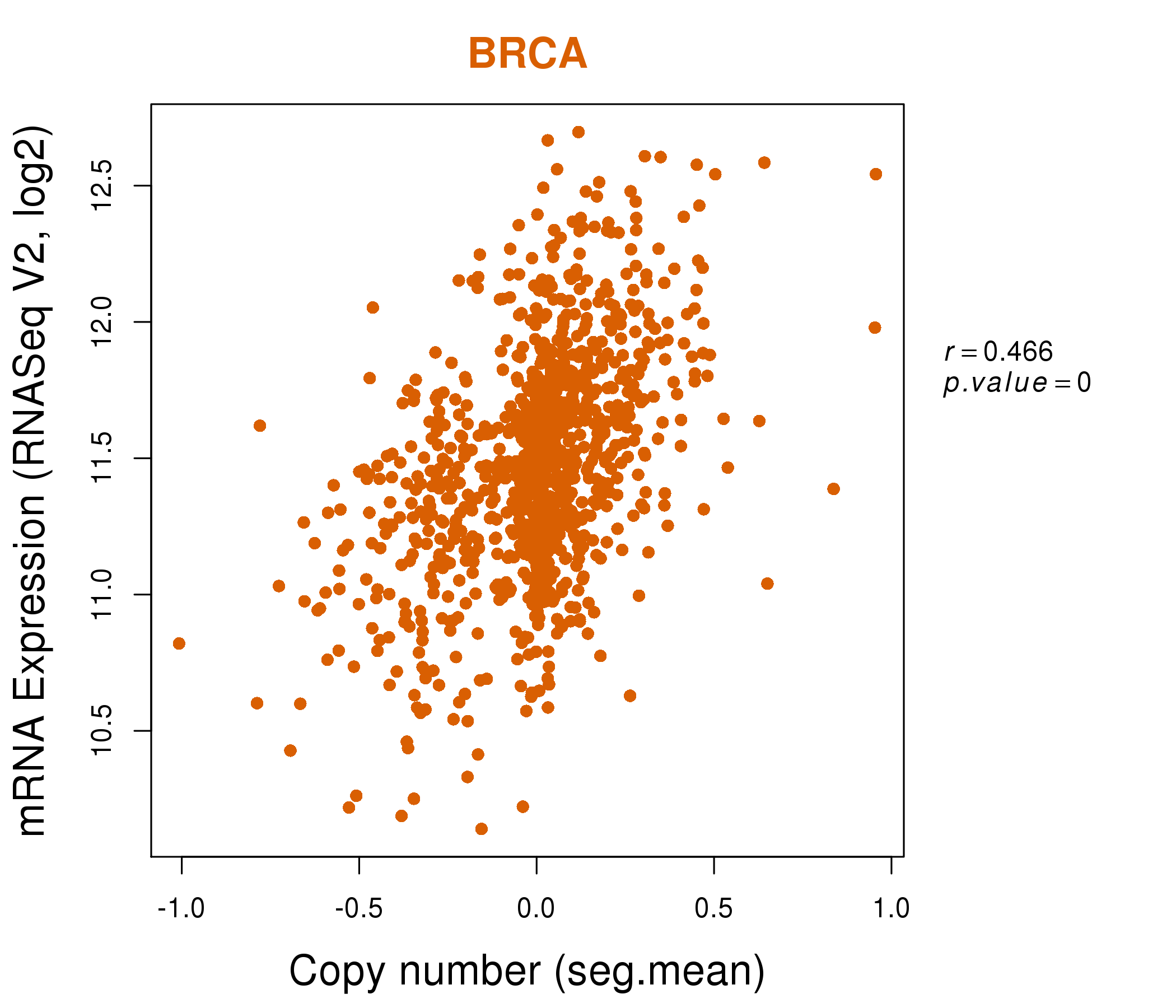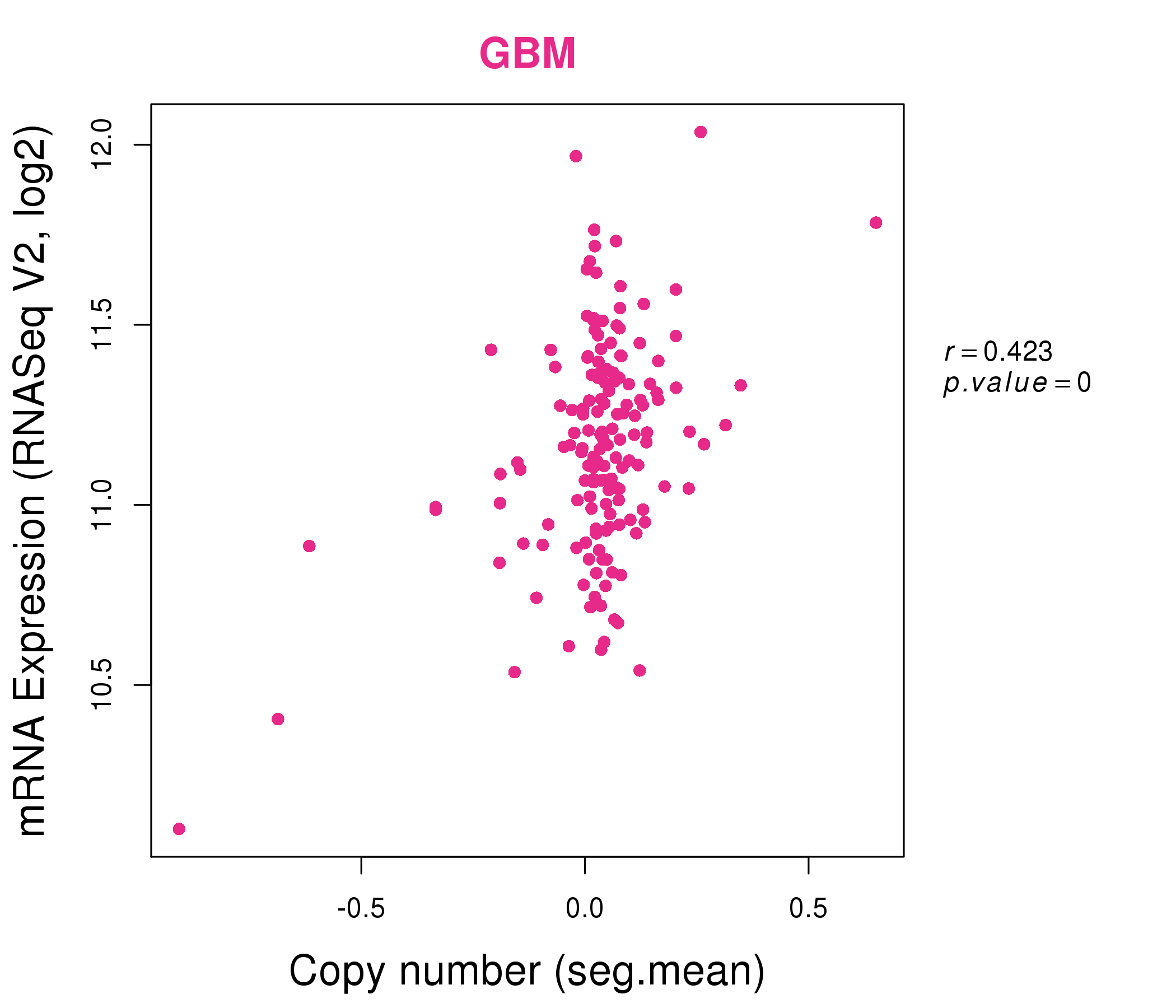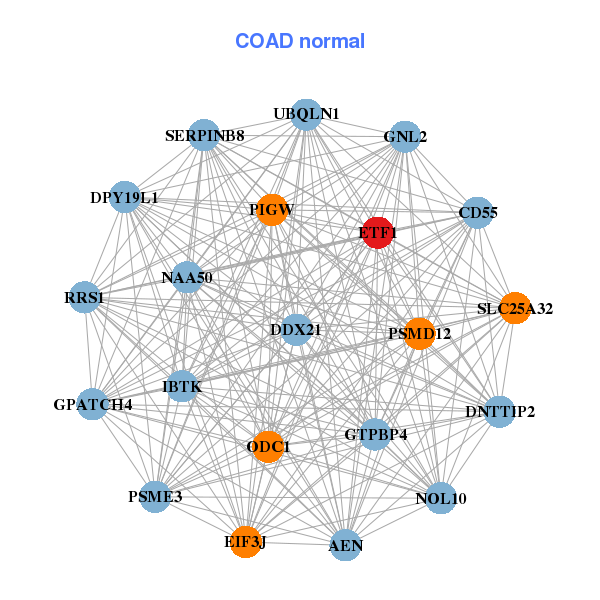|
||||||||||||||||||||
| |
| Phenotypic Information (metabolism pathway, cancer, disease, phenome) |
| |
| |
| Gene-Gene Network Information: Co-Expression Network, Interacting Genes & KEGG |
| |
|
| Gene Summary for ETF1 |
| Top |
| Phenotypic Information for ETF1(metabolism pathway, cancer, disease, phenome) |
| Cancer | CGAP: ETF1 |
| Familial Cancer Database: ETF1 | |
| * This gene is included in those cancer gene databases. |
|
|
|
|
|
| . | ||||||||||||||
Oncogene 1 | Significant driver gene in | |||||||||||||||||||
| cf) number; DB name 1 Oncogene; http://nar.oxfordjournals.org/content/35/suppl_1/D721.long, 2 Tumor Suppressor gene; https://bioinfo.uth.edu/TSGene/, 3 Cancer Gene Census; http://www.nature.com/nrc/journal/v4/n3/abs/nrc1299.html, 4 CancerGenes; http://nar.oxfordjournals.org/content/35/suppl_1/D721.long, 5 Network of Cancer Gene; http://ncg.kcl.ac.uk/index.php, 1Therapeutic Vulnerabilities in Cancer; http://cbio.mskcc.org/cancergenomics/statius/ |
| REACTOME_METABOLISM_OF_PROTEINS REACTOME_METABOLISM_OF_MRNA REACTOME_METABOLISM_OF_RNA | |
| OMIM | |
| Orphanet | |
| Disease | KEGG Disease: ETF1 |
| MedGen: ETF1 (Human Medical Genetics with Condition) | |
| ClinVar: ETF1 | |
| Phenotype | MGI: ETF1 (International Mouse Phenotyping Consortium) |
| PhenomicDB: ETF1 | |
| Mutations for ETF1 |
| * Under tables are showing count per each tissue to give us broad intuition about tissue specific mutation patterns.You can go to the detailed page for each mutation database's web site. |
| - Statistics for Tissue and Mutation type | Top |
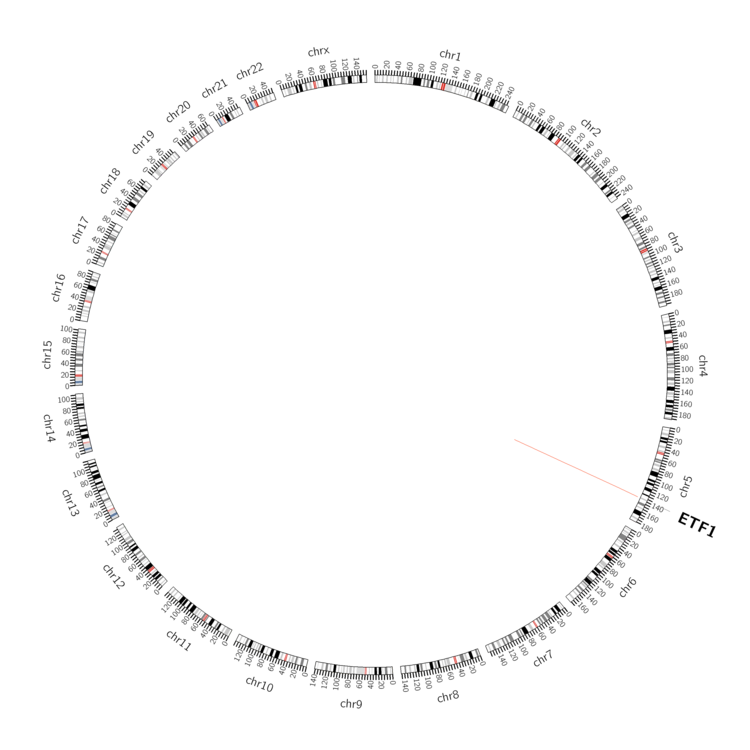 |
| - For Inter-chromosomal Variations |
| There's no inter-chromosomal structural variation. |
| - For Intra-chromosomal Variations |
| * Intra-chromosomal variantions includes 'intrachromosomal amplicon to amplicon', 'intrachromosomal amplicon to non-amplified dna', 'intrachromosomal deletion', 'intrachromosomal fold-back inversion', 'intrachromosomal inversion', 'intrachromosomal tandem duplication', 'Intrachromosomal unknown type', 'intrachromosomal with inverted orientation', 'intrachromosomal with non-inverted orientation'. |
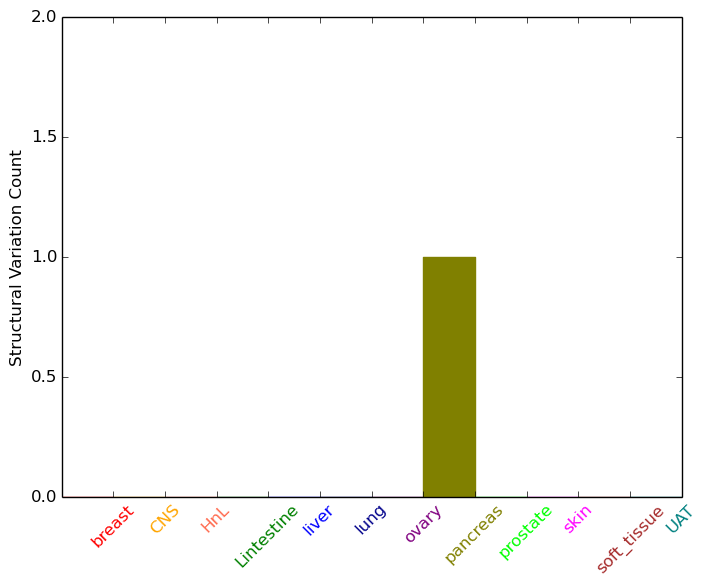 |
| Sample | Symbol_a | Chr_a | Start_a | End_a | Symbol_b | Chr_b | Start_b | End_b |
| pancreas | ETF1 | chr5 | 137850104 | 137850124 | ETF1 | chr5 | 137850276 | 137850296 |
| cf) Tissue number; Tissue name (1;Breast, 2;Central_nervous_system, 3;Haematopoietic_and_lymphoid_tissue, 4;Large_intestine, 5;Liver, 6;Lung, 7;Ovary, 8;Pancreas, 9;Prostate, 10;Skin, 11;Soft_tissue, 12;Upper_aerodigestive_tract) |
| * From mRNA Sanger sequences, Chitars2.0 arranged chimeric transcripts. This table shows ETF1 related fusion information. |
| ID | Head Gene | Tail Gene | Accession | Gene_a | qStart_a | qEnd_a | Chromosome_a | tStart_a | tEnd_a | Gene_a | qStart_a | qEnd_a | Chromosome_a | tStart_a | tEnd_a |
| BG534374 | HLA-E | 2 | 256 | 6 | 1789579 | 1789963 | ETF1 | 249 | 621 | 5 | 137846830 | 137848637 | |
| DB041334 | LOC100507412 | 1 | 148 | ? | 112032 | 112179 | ETF1 | 149 | 447 | 5 | 137854497 | 137878920 | |
| Top |
| There's no copy number variation information in COSMIC data for this gene. |
| Top |
|
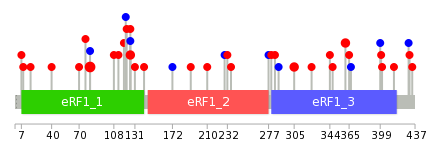 |
| Top |
| Stat. for Non-Synonymous SNVs (# total SNVs=31) | (# total SNVs=7) |
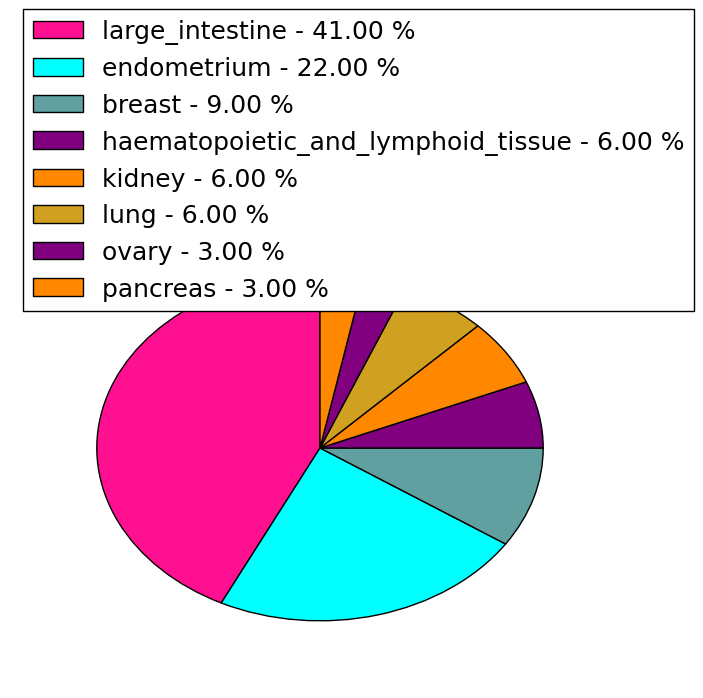 | 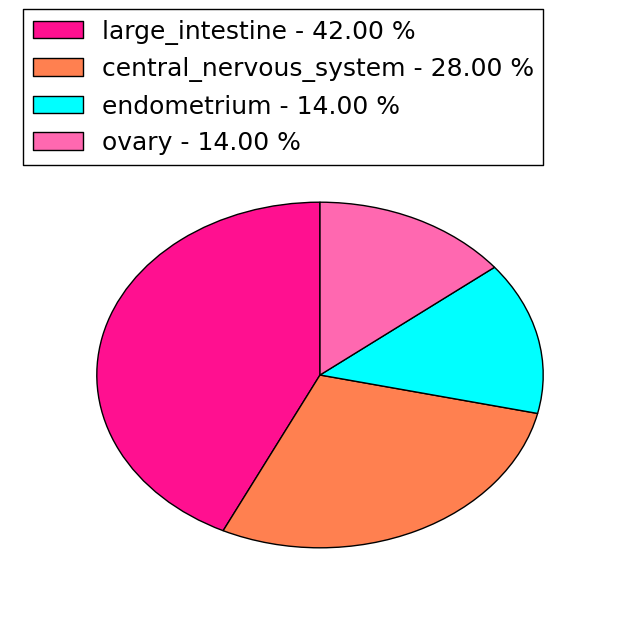 |
(# total SNVs=0) | (# total SNVs=0) |
| Top |
| * When you move the cursor on each content, you can see more deailed mutation information on the Tooltip. Those are primary_site,primary_histology,mutation(aa),pubmedID. |
| GRCh37 position | Mutation(aa) | Unique sampleID count |
| chr5:137854398-137854398 | p.L82P | 4 |
| chr5:137846256-137846256 | p.E361Q | 2 |
| chr5:137846839-137846839 | p.V305I | 2 |
| chr5:137853275-137853275 | p.L126S | 2 |
| chr5:137854434-137854434 | p.S70L | 1 |
| chr5:137848455-137848455 | p.Q244* | 1 |
| chr5:137853276-137853276 | p.L126L | 1 |
| chr5:137844008-137844008 | p.L434F | 1 |
| chr5:137846286-137846286 | p.E351* | 1 |
| chr5:137854525-137854525 | p.P40S | 1 |
| Top |
|
 |
| Point Mutation/ Tissue ID | 1 | 2 | 3 | 4 | 5 | 6 | 7 | 8 | 9 | 10 | 11 | 12 | 13 | 14 | 15 | 16 | 17 | 18 | 19 | 20 |
| # sample | 2 | 1 | 15 | 2 | 2 | 1 | 1 | 2 | 2 | 3 | 5 | 1 | 6 | |||||||
| # mutation | 2 | 1 | 12 | 2 | 2 | 1 | 1 | 2 | 2 | 3 | 5 | 1 | 7 | |||||||
| nonsynonymous SNV | 2 | 1 | 9 | 2 | 1 | 1 | 2 | 1 | 2 | 3 | 1 | 6 | ||||||||
| synonymous SNV | 3 | 2 | 1 | 1 | 2 | 1 |
| cf) Tissue ID; Tissue type (1; BLCA[Bladder Urothelial Carcinoma], 2; BRCA[Breast invasive carcinoma], 3; CESC[Cervical squamous cell carcinoma and endocervical adenocarcinoma], 4; COAD[Colon adenocarcinoma], 5; GBM[Glioblastoma multiforme], 6; Glioma Low Grade, 7; HNSC[Head and Neck squamous cell carcinoma], 8; KICH[Kidney Chromophobe], 9; KIRC[Kidney renal clear cell carcinoma], 10; KIRP[Kidney renal papillary cell carcinoma], 11; LAML[Acute Myeloid Leukemia], 12; LUAD[Lung adenocarcinoma], 13; LUSC[Lung squamous cell carcinoma], 14; OV[Ovarian serous cystadenocarcinoma ], 15; PAAD[Pancreatic adenocarcinoma], 16; PRAD[Prostate adenocarcinoma], 17; SKCM[Skin Cutaneous Melanoma], 18:STAD[Stomach adenocarcinoma], 19:THCA[Thyroid carcinoma], 20:UCEC[Uterine Corpus Endometrial Carcinoma]) |
| Top |
| * We represented just top 10 SNVs. When you move the cursor on each content, you can see more deailed mutation information on the Tooltip. Those are primary_site, primary_histology, mutation(aa), pubmedID. |
| Genomic Position | Mutation(aa) | Unique sampleID count |
| chr5:137854398 | p.L68P,ETF1 | 4 |
| chr5:137846839 | p.E347Q,ETF1 | 2 |
| chr5:137853275 | p.L112S,ETF1 | 2 |
| chr5:137846256 | p.V291I,ETF1 | 2 |
| chr5:137846306 | p.F417F,ETF1 | 1 |
| chr5:137848611 | p.E255Q,ETF1 | 1 |
| chr5:137854397 | p.E416E,ETF1 | 1 |
| chr5:137844008 | p.L222R,ETF1 | 1 |
| chr5:137849377 | p.S63F,ETF1 | 1 |
| chr5:137844015 | p.R400W,ETF1 | 1 |
| * Copy number data were extracted from TCGA using R package TCGA-Assembler. The URLs of all public data files on TCGA DCC data server were gathered on Jan-05-2015. Function ProcessCNAData in TCGA-Assembler package was used to obtain gene-level copy number value which is calculated as the average copy number of the genomic region of a gene. |
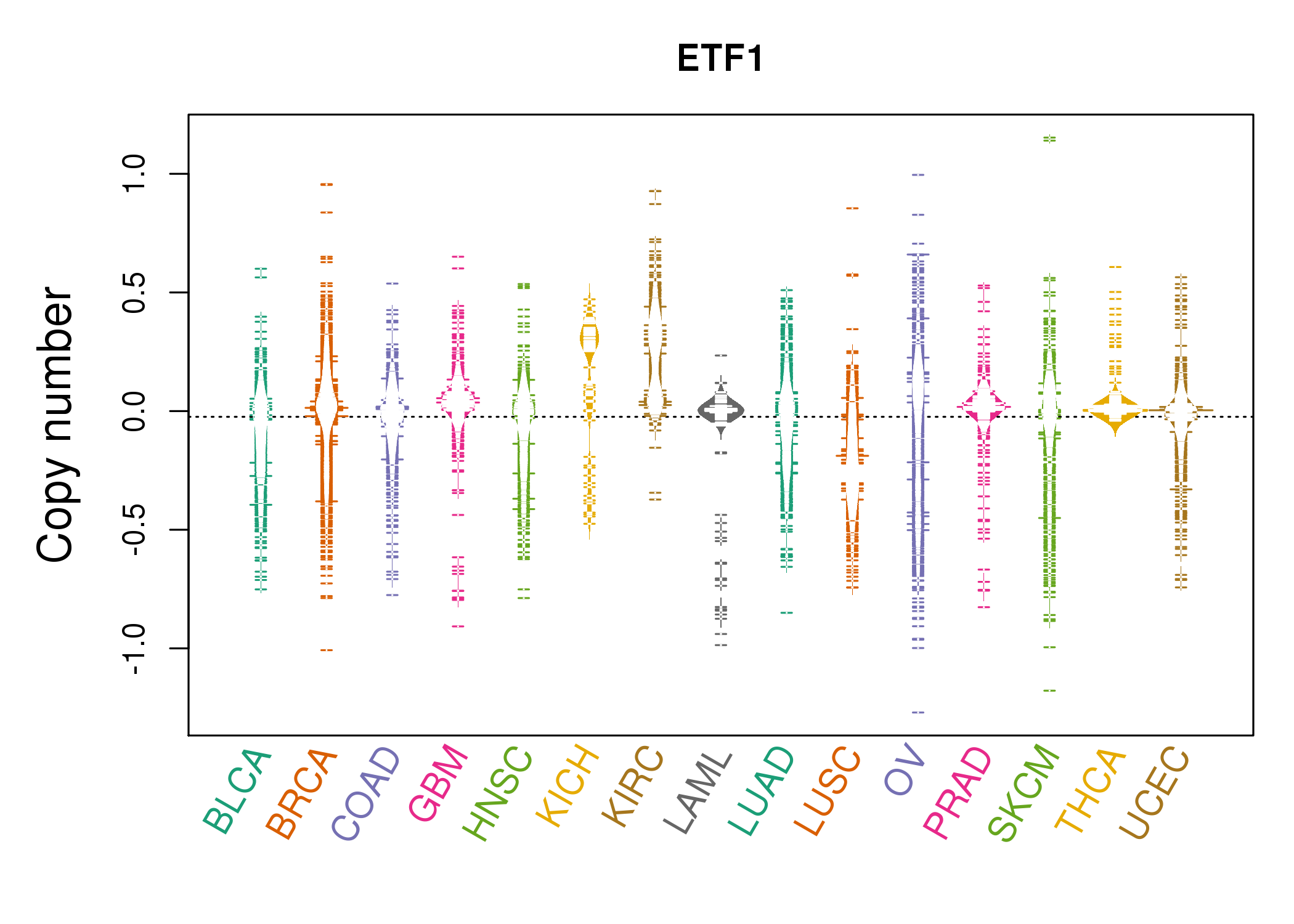 |
| cf) Tissue ID[Tissue type]: BLCA[Bladder Urothelial Carcinoma], BRCA[Breast invasive carcinoma], CESC[Cervical squamous cell carcinoma and endocervical adenocarcinoma], COAD[Colon adenocarcinoma], GBM[Glioblastoma multiforme], Glioma Low Grade, HNSC[Head and Neck squamous cell carcinoma], KICH[Kidney Chromophobe], KIRC[Kidney renal clear cell carcinoma], KIRP[Kidney renal papillary cell carcinoma], LAML[Acute Myeloid Leukemia], LUAD[Lung adenocarcinoma], LUSC[Lung squamous cell carcinoma], OV[Ovarian serous cystadenocarcinoma ], PAAD[Pancreatic adenocarcinoma], PRAD[Prostate adenocarcinoma], SKCM[Skin Cutaneous Melanoma], STAD[Stomach adenocarcinoma], THCA[Thyroid carcinoma], UCEC[Uterine Corpus Endometrial Carcinoma] |
| Top |
| Gene Expression for ETF1 |
| * CCLE gene expression data were extracted from CCLE_Expression_Entrez_2012-10-18.res: Gene-centric RMA-normalized mRNA expression data. |
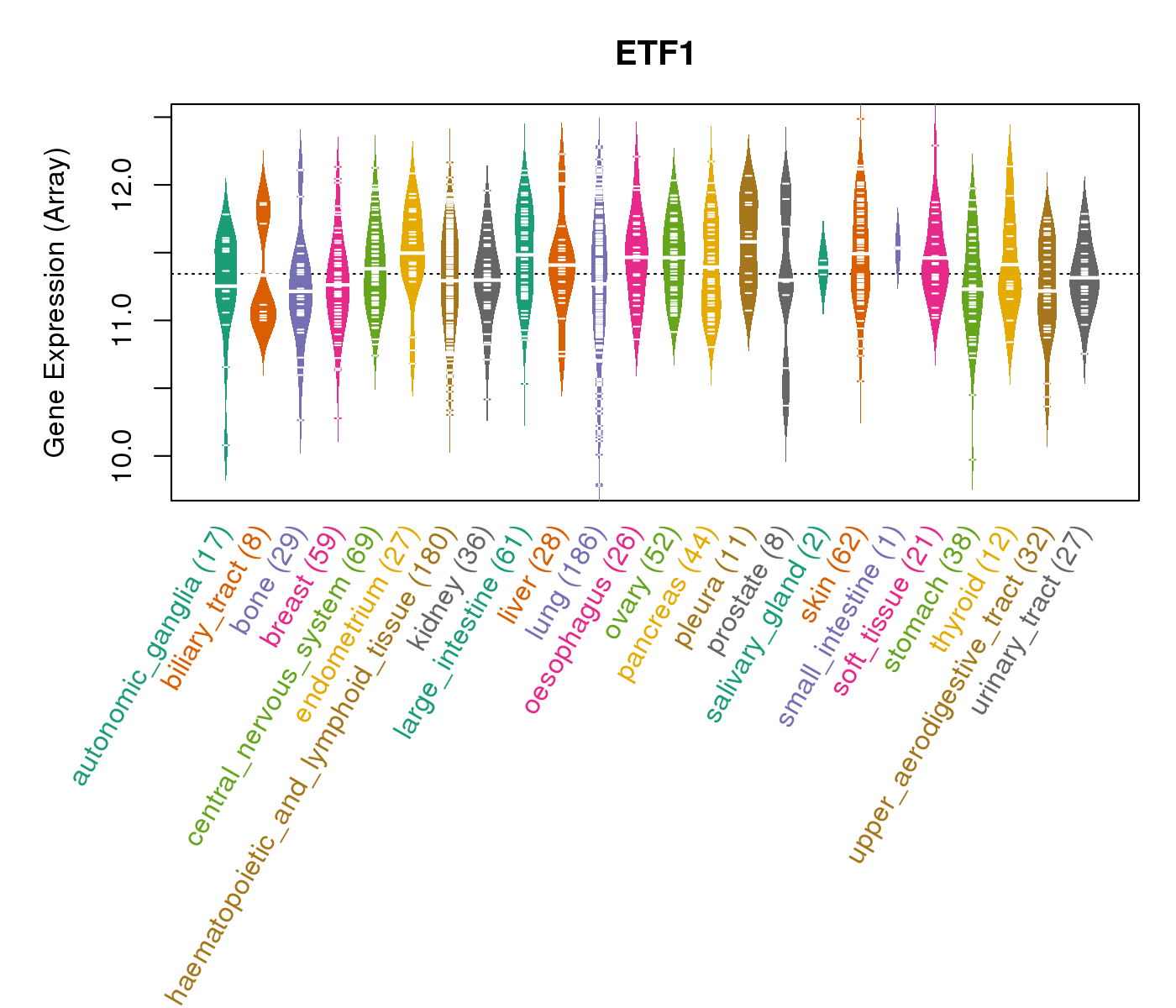 |
| * Normalized gene expression data of RNASeqV2 was extracted from TCGA using R package TCGA-Assembler. The URLs of all public data files on TCGA DCC data server were gathered at Jan-05-2015. Only eight cancer types have enough normal control samples for differential expression analysis. (t test, adjusted p<0.05 (using Benjamini-Hochberg FDR)) |
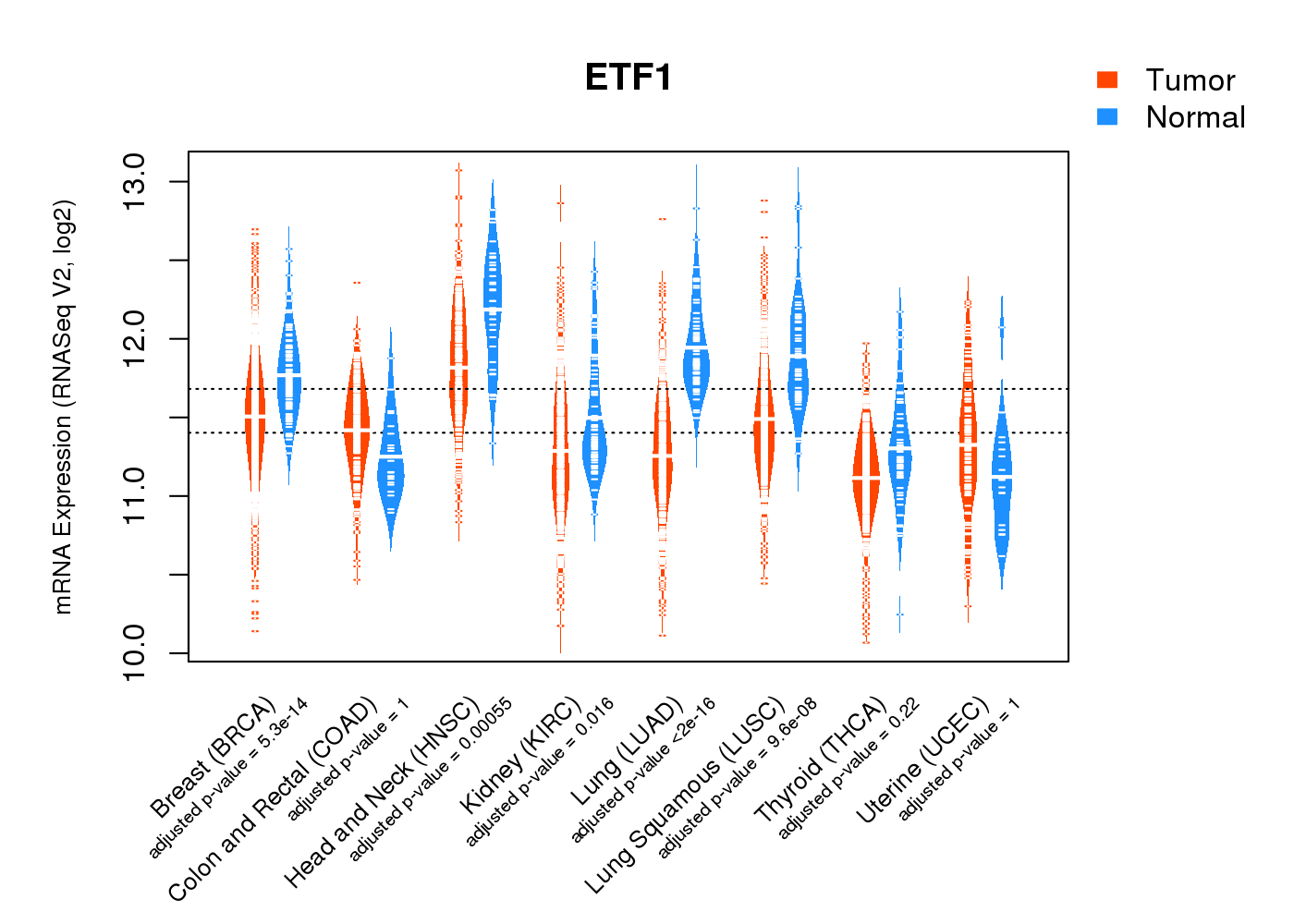 |
| Top |
| * This plots show the correlation between CNV and gene expression. |
: Open all plots for all cancer types
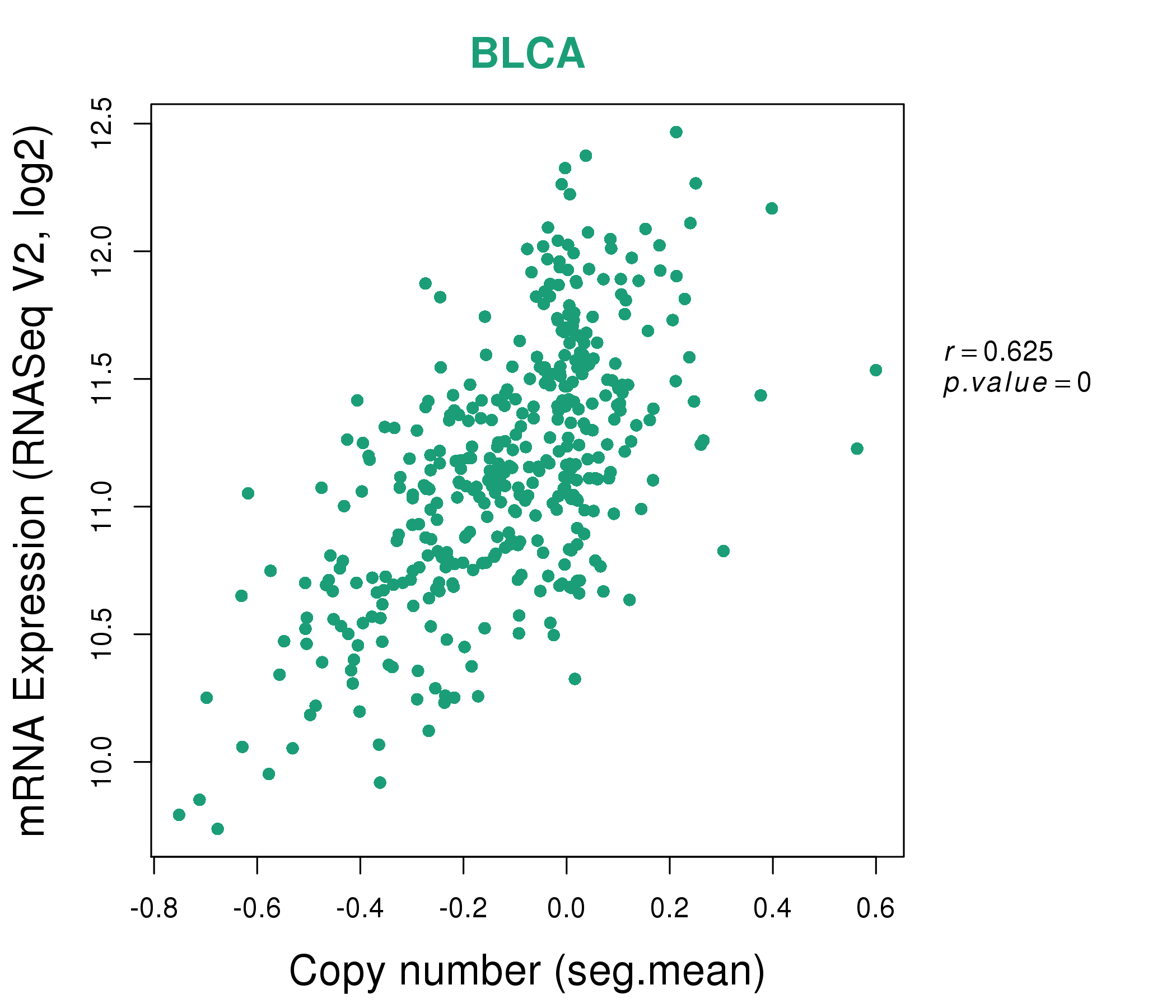 |
|
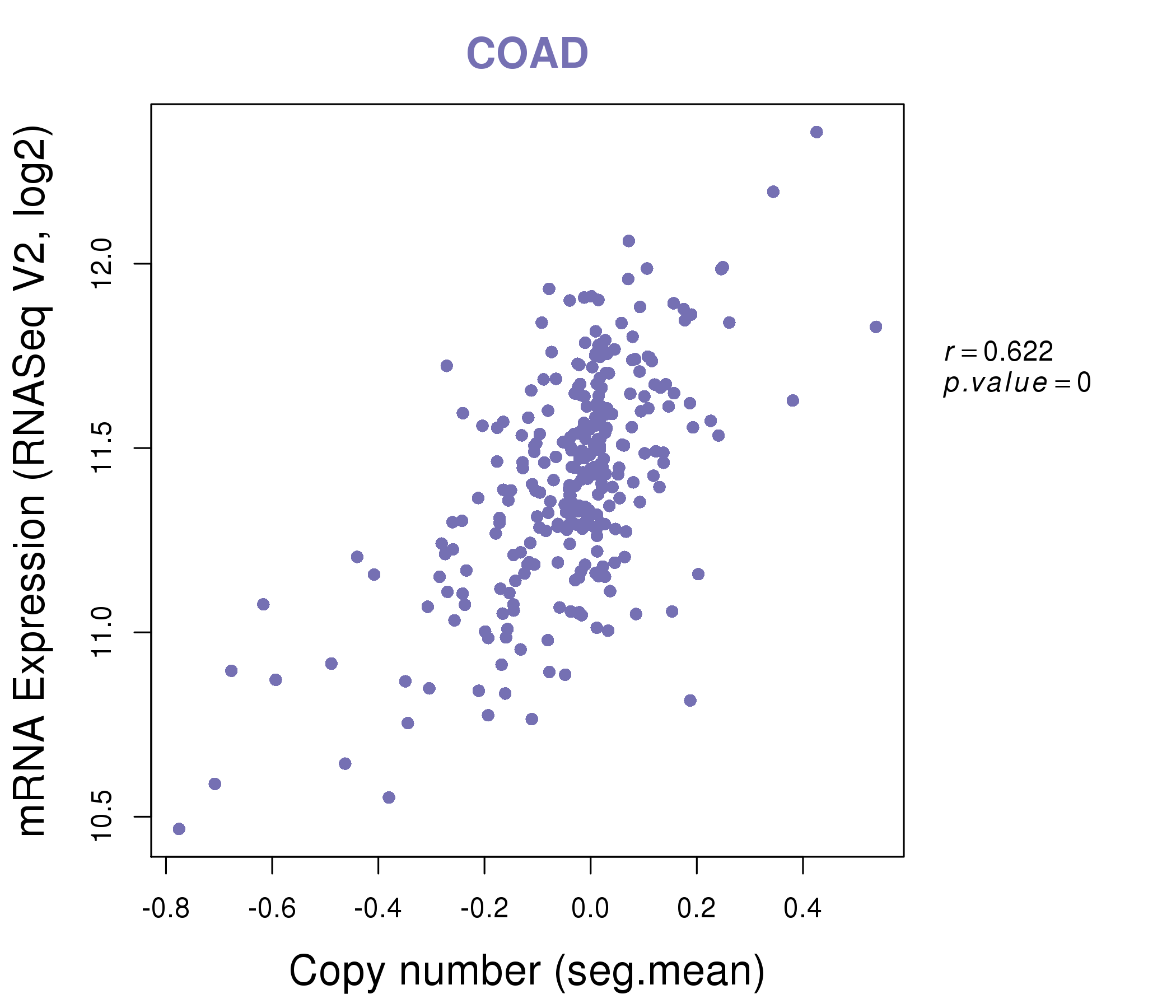 |
|
| Top |
| Gene-Gene Network Information |
| * Co-Expression network figures were drawn using R package igraph. Only the top 20 genes with the highest correlations were shown. Red circle: input gene, orange circle: cell metabolism gene, sky circle: other gene |
: Open all plots for all cancer types
 |
|
| AFF4,CDC23,CLINT1,CSNK1A1,DDX46,ETF1,FBXW11, G3BP1,GRPEL2,HSPA4,HSPA9,LARS,MATR3,PHAX, RARS,RBM27,SEC24A,SRFBP1,UTP15,WDR36,YIPF5 | AKIRIN1,BAG5,DTD2,MIR22HG,AAED1,CDV3,DCTN6, DEGS1,DNAJC25,DPH3,EIF2S1,ETF1,HAUS2,MAPRE1, PPP2CB,PWP1,RNF11,SBDSP1,STRAP,UBQLN1,YWHAZ |
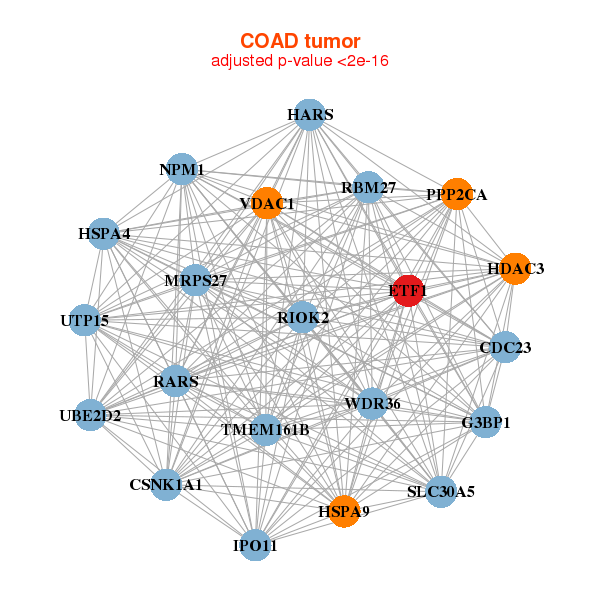 |
|
| CDC23,CSNK1A1,ETF1,G3BP1,HARS,HDAC3,HSPA4, HSPA9,IPO11,MRPS27,NPM1,PPP2CA,RARS,RBM27, RIOK2,SLC30A5,TMEM161B,UBE2D2,UTP15,VDAC1,WDR36 | AEN,CD55,DDX21,DNTTIP2,DPY19L1,EIF3J,ETF1, GNL2,GPATCH4,GTPBP4,IBTK,NAA50,NOL10,ODC1, PIGW,PSMD12,PSME3,RRS1,SERPINB8,SLC25A32,UBQLN1 |
| * Co-Expression network figures were drawn using R package igraph. Only the top 20 genes with the highest correlations were shown. Red circle: input gene, orange circle: cell metabolism gene, sky circle: other gene |
: Open all plots for all cancer types
| Top |
: Open all interacting genes' information including KEGG pathway for all interacting genes from DAVID
| Top |
| Pharmacological Information for ETF1 |
| There's no related Drug. |
| Top |
| Cross referenced IDs for ETF1 |
| * We obtained these cross-references from Uniprot database. It covers 150 different DBs, 18 categories. http://www.uniprot.org/help/cross_references_section |
: Open all cross reference information
|
Copyright © 2016-Present - The Univsersity of Texas Health Science Center at Houston @ |






